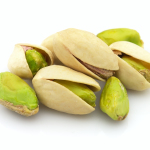Pistachios grow well under hot, dry climates with cool winters. They are currently being cultivated in large scale in the orchards in the USA, Iran, Syria, Turkey, and China. The fruit, in fact, is a drupe (fruit with a large, central located single seed), and its seed kernel is actually the edible portion. On the exterior, the mature fruit features hard, off-white color shell which splits apart exposing yellow-light green, oblong shape kernel inside. Pistachio kernel measures about 1 inch in length and 1/2 inch in diameter and weighs about 0.7-1 gm. Pistachios are delicious tree nuts recognized for their wholesome nutrition properties. Together with walnuts, almonds and cashews, they form important source of protein, fats, and minerals to otherwise dry and arid regions of Central, West and South Asian population.
Pistachios are rich source of energy; 100 g of nuts provides 557 calories. In addition, they are rich in mono-unsaturated fatty acids like oleic acid and an excellent source of antioxidants. Regular consumption of pistachios in the diet helps to lower total as well as bad LDL cholesterol and increases good HDL cholesterol levels within the blood. Research studies suggest that Mediterranean diet that is rich in dietary-fiber, mono-unsaturated fatty acids, and antioxidants help to prevent coronary artery disease and strokes by favoring healthy blood lipid profile.




